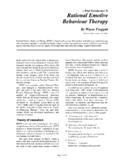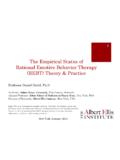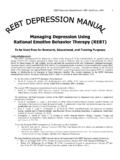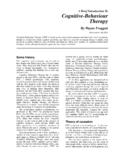Transcription of Rational Emotive Education - REBT Network: Albert Ellis
1 HelpAndManual_unregistered_evaluation_co py Rational Emotive Education Dr. William J. Knaus I Rational Emotive Education Table of Contents Part I Preface & Introduction 1. 1 Preface .. 1. 2 Introduction .. 5. Part II The Nature of Rational - Emotive Education (REE) 6. 1 Background .. 6. 2 Content of REE.. Program 7. 3 Technique .. 8. REE is Compatible .. with Current Educational Systems 8. REE Is an Effective .. System 9. Part III Orientation to the Principles of Rational - Emotive Therapy People's Irrational Assumptions 14. 1 The task of the .. Rational - Emotive Therapist or Counselor 17. 2 RET: An Educational .. System 18. 3 The ABC Theory .. of Emotions 18. The Two Faces .. of B 19. D - Disputing .. Irrational Beliefs 20. E - The Cognitive-Affective-Behavioral .. Effect 20. 4 Perspective and .. Change 21. 5 Biological and .. Environmental Influences on Behavior 22.
2 Part IV Feelings: The Basics in Rational - Emotive Education 24. 1 Background .. for the Teacher 24. 2 Student Activity .. 1: Feelings 25. 3 Student Activity .. 2: The Expression Guessing Game 26. 4 Student Activity .. 3: Where Feelings Come from 28. Homework Assignment .. 30. 5 Student Activity .. 4: The Happening-Thought-Feeling Reaction Diagram (HTFR) 30. Homework Assignment .. 32. Part V The Art of Challenging Irrational Beliefs through Self-questioning and Action 33. 1 Background .. for the Teacher 33. 2 Student Activity .. I: The First Step in Challenging 34. 3 Student Activity .. 2: The Emotional Experience Scales 36. 4 Student Activity .. 3: "Mr. Head" (Brody, 1973) 38. William J. Knaus Contents II. 5 Student Activity .. 4: Using Challenging Techniques 39. Homework Assignment .. 41. Part VI Challenging Feelings of Inferiority 42. 1 Background .. for the Teacher 42.
3 2 Student Activity .. 1: Simple and Complex 42. Homework Assignment .. 44. 3 Student Activity .. 2: The Self-Concept Pin-Wheel (for children under 10) 44. 4 Student Activity .. 2: The Self-Concept Circle (for children over 10) 48. 5 Student Activity .. 3: Upset A Game to Demonstrate Irrationality 49. 6 Student Activity .. 4: Challenge A Game to Demonstrate Rationality 51. Supplementary .. Activities 53. Part VII Learning, Mistake-making, and Imperfection 54. 1 Background .. for the Teacher 54. 2 Student Activity .. 1: How People Learn 55. Homework Assignment .. 57. 3 Student Activity .. 2: Facts and Opinions 58. Supplementary .. Activities 59. Review and Preview .. 59. Homework Assignment .. 60. 4 Student Activity .. 3: Why People Have Different Opinions 61. 5 Student Activity .. 4: Why People Make Unsound Assumptions 65. Reinforcement: .. 68. The Huddle .. Game, a game of assumptive rejection 68.
4 Rumor Circle .. 69. Homework Assignment .. 70. 6 Student Activity .. 5: The Imperfect Person in the Imperfect World 70. Homework Assignment .. 73. 7 Student Activity .. 6: Why People Make Mistakes 74. Supplementary .. Activity 76. Part VIII Demanding, Catastrophizing, and Challenging 77. 1 Background .. for the Teacher 77. 2 Student Activity .. 1: Demands and Desires 78. 3 Student Activity .. 2: The Many Faces of "Troubles" 80. 4 Student Activity .. 3: Touchy Joe 84. Homework Assignment .. 85. 5 Student Activity .. 4: Catastrophizing or "Awfulizing" 85. Supplementary .. Activity 88. 6 Student Activity .. 5: Can You be a Perfect Challenger? 88. Homework Assignment .. 89. Part IX Special Topics 90. 1 Responsibility, .. Roles and Rules 90. REBT Network III Rational Emotive Education Student Activity .. 1: Responsibility, Roles and Rules 90. Reinforcement .. 92.
5 Supplementary .. Activities 93. 2 Perspective .. 93. Background for .. the Teacher 93. Student Activity .. 1: Defining and Examining Perspective 94. Student Activity .. 2: Examining a Story from Different Perspectives 95. Reinforcement .. 97. Supplementary .. Activity 97. 3 97. Student Activity .. 1: Defining and Examining Stereotyping 97. Student Activity .. 2: Sex Stereotyping 99. Reinforcement .. 102. Student Activity .. 3: Prejudice and Discrimination 102. Reinforcement .. 103. Student Activity .. 4: The Special Child in the Regular Classroom 103. 4 Teasing Name-Calling 106. Student Activity .. 1: Defining and Examining Teasing and Name-calling 106. Reinforcement .. 109. 5 Bullies, Vicitms, .. & Bystanders 109. Student Activity .. 1: Defining and Examining Bullying 109. Student Activity .. 2: Defining and Examining Victims 113. Student Activity .. 3: Bystanders 114.
6 Reinforcement .. 115. 6 Guided Protest: .. The Child as Consumer 115. Student Activity .. 1: The Child's Right to Protest 115. 7 117. Student Activity .. 1: Does the Rational Person Like Everyone? 117. Part X Epilogue 120. 1 This Is Not .. The 120. Part XI References 121. Part XII Glossary 123. Part XIII Glossary Of Affects 125. Part XIV Children's Survey Of Rational Beliefs 131. 1 Form B (Ages .. 7-10) 131. 2 Form C (Ages .. 10-13) 134. 3 Answer Key: .. Children's Survey Of Rational Beliefs 142. William J. Knaus Preface & Introduction 1. 1 Preface & Introduction Preface With the publication of this pioneer manual by Dr. William Knaus, Rational Emotive training (RET) indeed reaches a notable milestone. When I first started developing Rational psychotherapy (as it was called in its early days) in the beginning of 1955, I. had only a vague idea of where and how far it would eventually go.
7 I viewed it largely as a psychotherapeutic method that was distinctly more efficient with individual, face-to-face clients than were the then existing other major therapies: especially psychoanalysis and nondirective or client-centered modes of treatment. As subsequent clinical experience and experimental studies have shown, I was probably right about this. In the process of developing and expanding RET theory and practice, I had many second, third, and fourth thoughts about the whole field of psychotherapy and about Rational - Emotive therapy in particular. First of all, I applied it to group therapy (around 1958) and to marathon therapy around 1964 and discovered that using it in groups was in many ways more effective and beneficial than using it only in one-to-one encounters. Secondly, I began employing it (around I960) with large groups of individuals (in one instance, as many as three hundred and fifty) in the course of public demonstrations and workshops.
8 Thirdly, I started to experiment with recorded and film presentations of RET (as early as 1956) and discovered, almost by accident, that vicarious therapy could be influential and potent. Fourthly, I. found that RET-trained individuals, particularly parents and spouses, could creatively use it with other troubled people, such as their children and mates. Fifthly, I came up with the idea of teaching Rational - Emotive psychology to children in the course of their regular classroom activities; and, starting in 1967. I began to concretize plans for establishing what shortly thereafter became The Living School, one of the very first elementary schools in the world primarily devoted to emotional REBT Network 2 Rational Emotive Education Education , in addition to teaching its pupils the fundamentals of academic Education . The more I employed and developed RET in these various ways, the more I began to conceive of it as a form of preventive and therapeutic treatment of emotional disturbances that truly follows the educational model.
9 This kind of model may well have been the original one of psychotherapy: since what we now call psychological treatment was mostly given, originally by philosophers, clergymen, and educators, who largely used didactic means of getting over healthy or Rational ideas to their "clients." But by the time the end of the nineteenth century had arrived, the educational model had officially been replaced by what has often been called the medical model of psychotherapy: as notably practiced and taught, for example, by such outstanding therapists as Bernheim and Janet. This model, in turn, has been largely superseded by the psycho-dynamic model--which was significantly developed by Freud, Jung, Adler and a host of other psychoanalytic and neo-psychoanalytic thinkers. Only recently, especially since the 1950's, has a revised version of the educational or training model of psychotherapy become more popular.
10 Where the psychodynamic paradigm, and its later offshoot, the relationship model, have clearly emphasized one-to-one encounters and small-group processes, the educational modes of behavior change have gone beyond this and have stressed the training of large-scale groups as well as the treatment of so-called "normal" or healthy" populations. Thus, behavior modifiers, especially the followers of B. F. Skinner and Joseph Wolpe, have frequ- ently used "therapeutic" procedures with whole populations of school children, inmates of various kinds of institutions, and workers in industry; and have done their best, in various ways, to "shape" the motivations and behaviors of these individuals in presumably beneficial directions. RET has, if possible, even more inclusive goals. If its theories and practices are health inducing as an increasing number of experimental studies are now demonstrating that they are its goal is, at least eventually, to make them available to William J.





